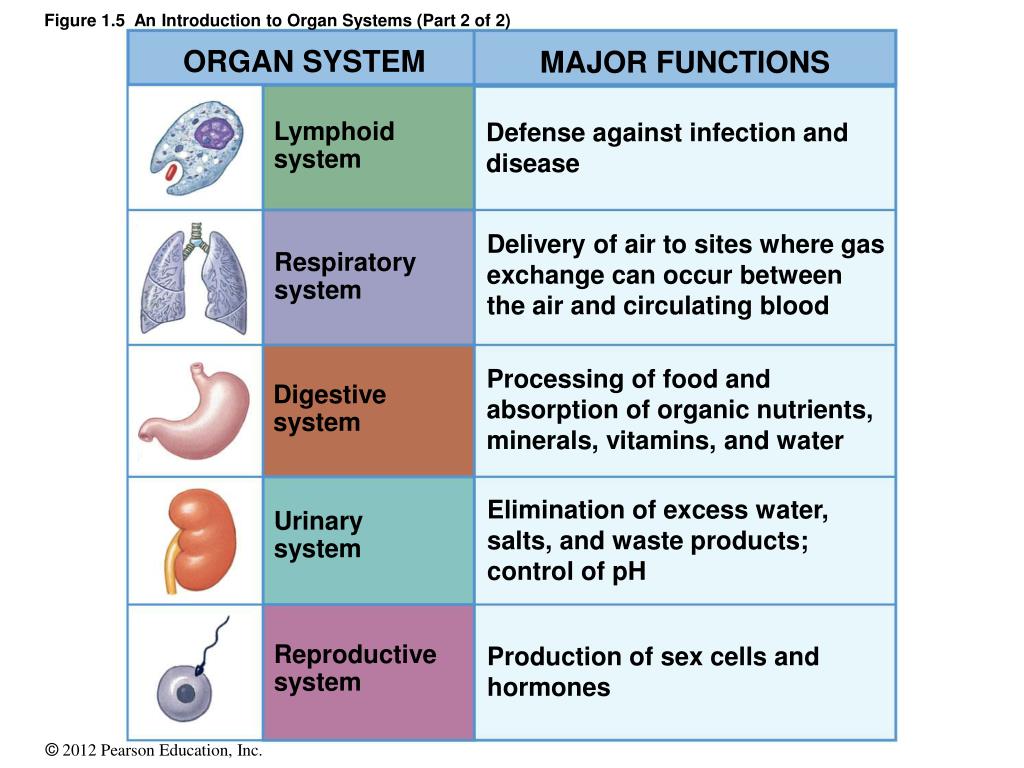What Are The 11 Organ Systems. The 11 major organ systems and their main functions are: These systems include the integumentary system, skeletal system, muscular system, lymphatic system, respiratory system, digestive system, nervous system, endocrine system, cardiovascular system, urinary system, and reproductive systems.
The human body has 11 different organ systems. All of these are required for survival, either of the person or of the species. There are eleven organ systems in the human body. Some of the organs and functions of the organ systems are identified in the figure. Keeps the body's temperature in a safe range.

Start studying 11 body systems.
There are eleven organ systems in the human body. The 11 major organ systems and their main functions are: The 11 organ systems of the human body nervous (signaling) respiratory (gas exchange) urinary (waste) muscular (movement) skeletal (support structure) cardiovascular (circulation) reproductive (sexual reproduction) lymphatic (vascular) immune (defense) marian university What part of anatomy is hardest? Keeps the body's temperature in a safe range. In the pyramid of life that organizes all of the elements of life into categories, organ systems are nested between an organism and its organs. The human body has 11 different organ systems. Figure \(\pageindex{3}\) and figure \(\pageindex{4}\) show 11 human organ systems, including separate diagrams for the male and female reproductive systems. The 11 organ systems of the body are the integumentary, muscular, skeletal, nervous, circulatory, lymphatic, respiratory, endocrine, urinary/excretory, reproductive and digestive. The body is made up of eleven organ systems, they all have specific functions but are interrelated to each other. All of these are required for survival, either of the person or of the species. All systems in our bodies have organs that take care of a necessary function for life. Learn vocabulary, terms, and more with flashcards, games, and other study tools.
The body is made up of eleven organ systems, they all have specific functions but are interrelated to each other. The human body is made up of several organ systems that work together as one unit. Some of the organs and functions of the organ systems are identified in the figure. The 11 organ systems of the human body nervous (signaling) respiratory (gas exchange) urinary (waste) muscular (movement) skeletal (support structure) cardiovascular (circulation) reproductive (sexual reproduction) lymphatic (vascular) immune (defense) marian university All of these are required for survival, either of the person or of the species.
The figure also lists the organs in each system and some roles for each system.
The 11 major organ systems and their main functions are: The 11 organ systems of the human body nervous (signaling) respiratory (gas exchange) urinary (waste) muscular (movement) skeletal (support structure) cardiovascular (circulation) reproductive (sexual reproduction) lymphatic (vascular) immune (defense) marian university Circulates blood around the body via the heart, arteries and veins, delivering oxygen and nutrients to organs and cells and carrying their waste products away.; The va defines 14 disability systems, which are similar to the body systems. Functionally related organs often cooperate to form whole organ systems. Start studying 11 organ systems. An organ system is a group of organs that work together to perform a complex function. All the best and believe in yourself. The 11 organ systems include the integumentary system, skeletal system, muscular system, lymphatic system, respiratory system, digestive system, nervous system, endocrine system, cardiovascular system, urinary system, and reproductive systems. Learn vocabulary, terms, and more with flashcards, games, and other study tools. All of these are required for survival, either of the person or of the species. It can be difficult to fully tease out the endocrine system from the other organ systems of vertebrate animals. Circulatory system / cardiovascular system:
Start studying 11 body systems. The 11 organ systems include the integumentary system, skeletal system, muscular system, lymphatic system, respiratory system, digestive system, nervous system, endocrine system, cardiovascular system, urinary system, and reproductive systems. This system converts ingested foods into smaller molecules your cells can harvest energy from. Circulatory system / cardiovascular system: Organ systems are the groups of organs that are within an organism.

Keeps the body's temperature in a safe range.
What are the 11 major organ systems in humans? The body is made up of eleven organ systems, they all have specific functions but are interrelated to each other. Some of the organs and functions of the organ systems are identified in the figure. We have covered much about them and their functions this past week. Figure \(\pageindex{3}\) and figure \(\pageindex{4}\) show 11 human organ systems, including separate diagrams for the male and female reproductive systems. The following are the 11 basic human organ systems: The main systems of the human body are: System to absorb nutrients and remove waste via the. This figure depicts the respiratory system. In the body itself, the parts that need to interact do interact, regardless of which system they have been grouped into. Start studying 11 body systems. Diseases and disorders of the reproductive system. All systems in our bodies have organs that take care of a necessary function for life.


0 comments:
Post a Comment